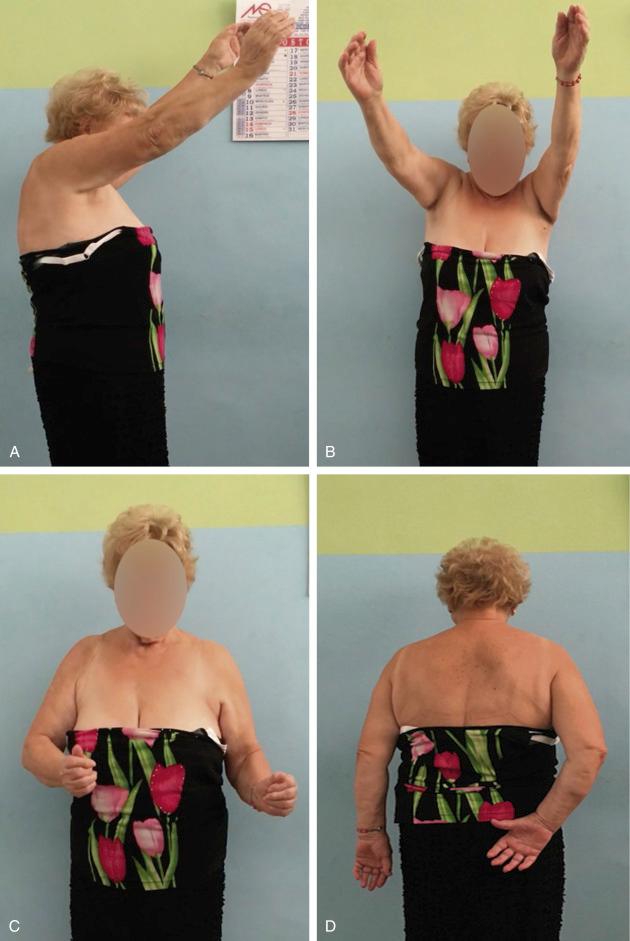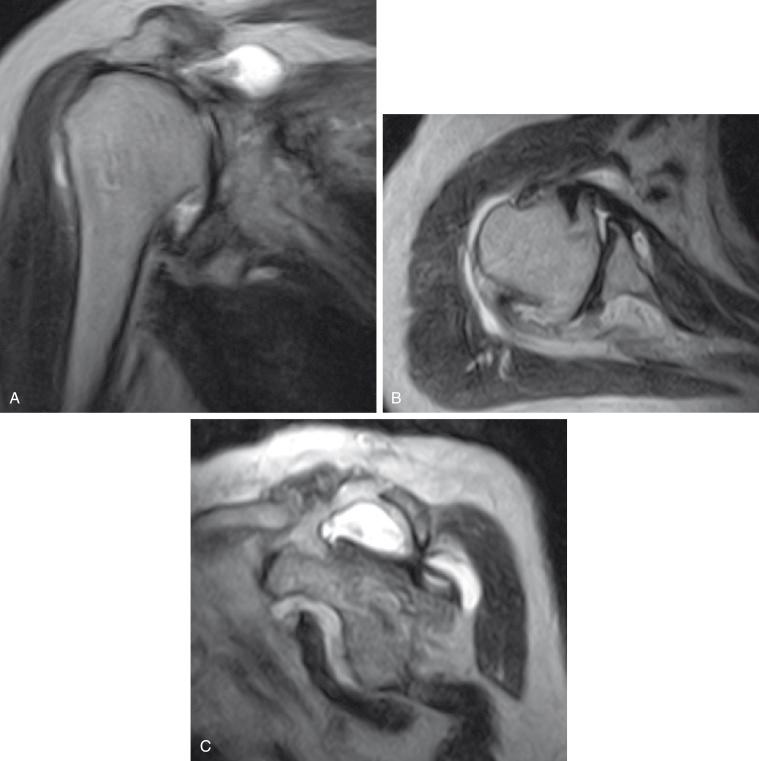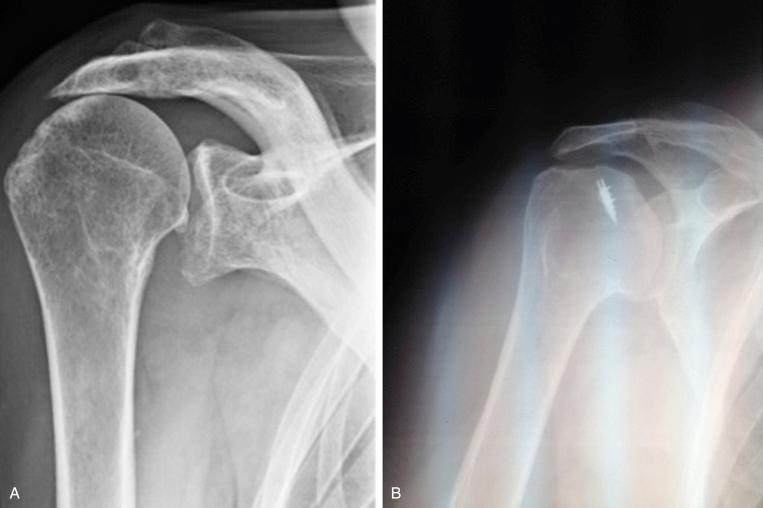Physical Address
304 North Cardinal St.
Dorchester Center, MA 02124
The term rotator cuff arthropathy was coined by Neer et al to indicate a nosologic condition characterized by arthritic degeneration of the glenohumeral joint consequent to the massive posterosuperior rotator cuff tear. About one century earlier, Adams, in his book on rheumatic gout, and Smith had described cases of shoulder arthropathy characterized by erosion of the upper portion of the humeral head, of the acromion, of the distal third of the clavicle and rotator cuff tear. Codman, in his monograph published in 1934, described a case of a 51-year-old woman whose shoulder underwent rotator cuff tear, glenohumeral arthropathy, loose bodies, and swelling for the abundant articular synovial fluid.
Further papers were not published until the end of the 1950s. Galmiche and Deshayes, Burman et al., Banna and Hume, Shephard, and Snook reported a total of 30 cases of shoulder arthropathy, some of them with the characteristics of cuff tear arthropathy.
In 1968, De Seze et al. described the hemorrhagic shoulder of three elderly women whose clinical (blood-streaked recurrent effusion, rotator cuff tear) and radiographic (severe degenerative glenohumeral humeral arthritis) characteristics suggesting a rotator cuff arthropathy. One year later, Bauduin and Famaey described an analogous case.
Jensen et al., in a prestigious publication in 1999, described the three main clinical and radiographic characteristics of the cuff arthropathy: (1) massive tear of the rotator cuff, associated with shoulder pain, supra- and infraspinatus atrophy, and loss of motion ( Fig. 36.1AD ); (2) degenerative changes of the glenohumeral joint ( Fig. 36.2A,B ); and (3) upward migration of the humeral head observable on anteroposterior view ( Fig. 36.3A ). Humeral head collapse ( Fig. 36.3B ), erosive changes of superior glenoid or acromion, periarticular soft-tissue calcifications, and subdeltoid effusion are other possible features that may be present.



According to mechanical theory, loss of downward force performed by a healthy rotator cuff on the humeral head would result in a superior migration of the humerus. This might facilitate an erosion of the superior surface of the glenoid and of the anteroinferior aspect of the acromion. In addition, the upward migration of the humeral head could cause eccentric work of the humeral head and, consequently, premature wear of the articular cartilage in the areas of higher glenohumeral compression. Because 21 of the 26 patients had the rupture of the long head of the biceps tendon, Neer et al thought that this injury would help the upward migration of the humeral head.
Burkhart’s hypothesis seems to support this theory. Burkhart believes that the healthy inferior portion of the rotator cuff creates a moment that must balance the deltoid moment (force coupling). Furthermore, the subscapularis is anteriorly balanced against the infraspinatus and teres minor posteriorly. Uncoupling of the essential force couples results in anterosuperior translation of the humeral head with attempted elevation of the shoulder.
In 1997, Collins and Harryman hypothesized that cuff arthropathy was initially due to supraspinatus tear and later to the infraspinatus lesion; the complex tendon tear would cause the upward migration of the humeral head and, consequently, the contact of articular cartilage of the humeral head against the anteroinferior margin of the acromion. Cartilage fragmentation results in particulate debris, which causes synovial thickening and effusion as well as calcium phosphate crystal formation. The enzymatic response to the crystals furthers the damage of the articular surfaces.
A concavity compression mechanism, suggested by Hurov, further corroborates the mechanical theory: The healthy cuff compresses the convexity of the humeral head against the pseudo-concavity of the glenoid; therefore the cuff, with other scapular muscles, would act as an important dynamic stabilizer of the joint. This action may be even more important in the presence of severe laxity of the static stabilizers of the shoulder (capsule, labrum, and glenohumeral ligaments). Oh et al identified that critical tear sizes responsible for disrupted joint kinematics are those with full-thickness supraspinatus tears and 50% detachment of the infraspinatus.
Neer et al. also suggested that osteoarthritis could depend on the loss of the “watertight” effect (loss of negative pressure normally existing inside the shoulder joint in normal conditions) due to the cuff tear. This would cause dispersion of synovial fluid, normally contained in the joint, in the subacromial space. The dispersion would make the diffusion of synovial fluid into the joint cartilage difficult; consequently, the cartilage would be poorly nourished and would easily run into atrophy. Furthermore, diffusion of the fluid into the cartilage should be further hindered by the decrease in range of motion caused by the shoulder pain due to the cuff tear (loss of water and mucopolysaccharide content). In addition, decrease in mobility, resulting in pain, would lead the subchondral bone to be osteoporotic and more exposed to possible collapse.
It is known that cytokine and catabolic enzyme concentrations increase in the early phases of osteoarthritis. Many studies have also proved that the rotator cuff tear leads to an increased production of interleukin-1β and tumor necrosis factor, which helps explain the presence of pain and inflammation. It was also noted that the production of many cartilage matrix–specific matrix metalloproteinases (MMPs) is increased, including MMP-1, MMP-2, MMP-3, MMP-8, and MMP-13. The presence of MMP-3 is important because it is implicated in the proteolytic activation of the other MMPs. Yoshihara et al. observed that there is a correlation between the concentration of these cytokines, collagenases, and aggrecanases and accelerated cartilage degeneration after a cuff tear.
These observations change the contours of the nutritional theory in the genesis of cuff tear arthropathy. In fact, with the evacuation of a part of the synovial fluid through the tendon lesion, inflammation factors and proteolytic enzymes should be removed, and thus the health status of articular cartilage should be preserved.
In 2012, Reuter et al. sonographically assessed the articular surface of the glenohumeral joint in rats with a rotator cuff tear and observed a thickness decrease in the cartilage. Kramer et al. histologically studied the glenohumeral cartilage of rats subjected, respectively, to detachment of the posterosuperior rotator cuff and to suprascapular nerve root transection passing through the trapezoid. (The joint capsule was kept intact.) The animals were killed 12 weeks after surgery. In the first case, if there had been degenerative changes of the cartilage, it would have been attributed, in accordance with Neer’s hypotheses, to the altered mechanical loading and to the nutritional theory; instead, in the second case, it would have been attributed only to the mechanical hypothesis. Surprisingly, the amount of cartilage degeneration was similar between the groups. This result suggests that aberrant mechanical forces are the primary cause of articular cartilage degeneration in the setting of cuff tear arthropathy.
Become a Clinical Tree membership for Full access and enjoy Unlimited articles
If you are a member. Log in here